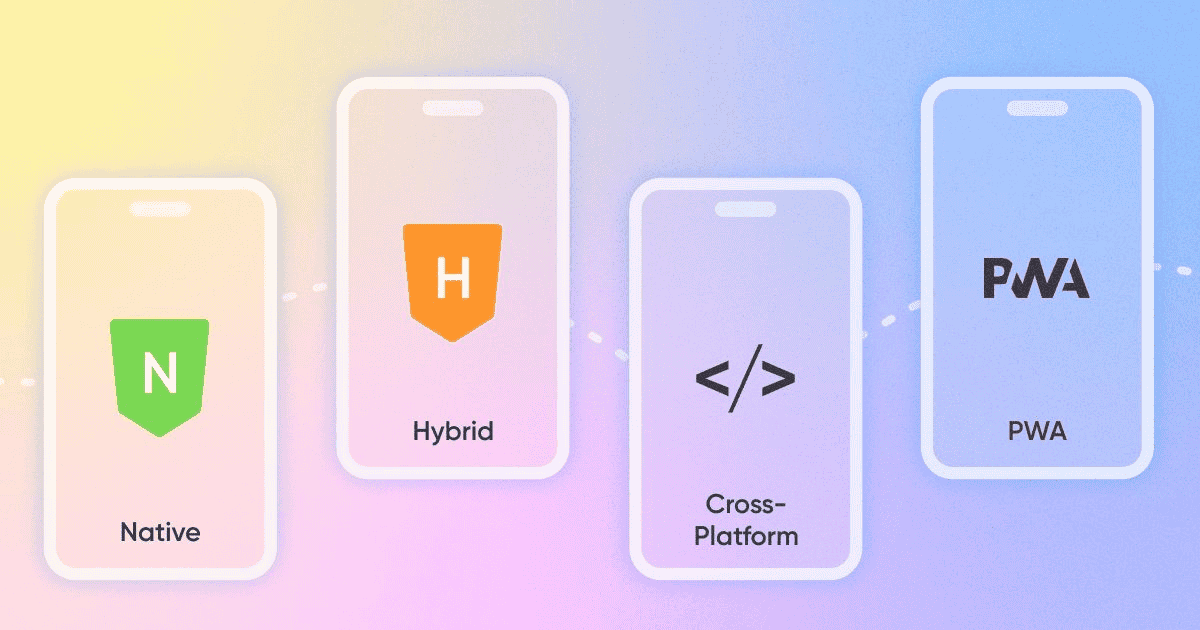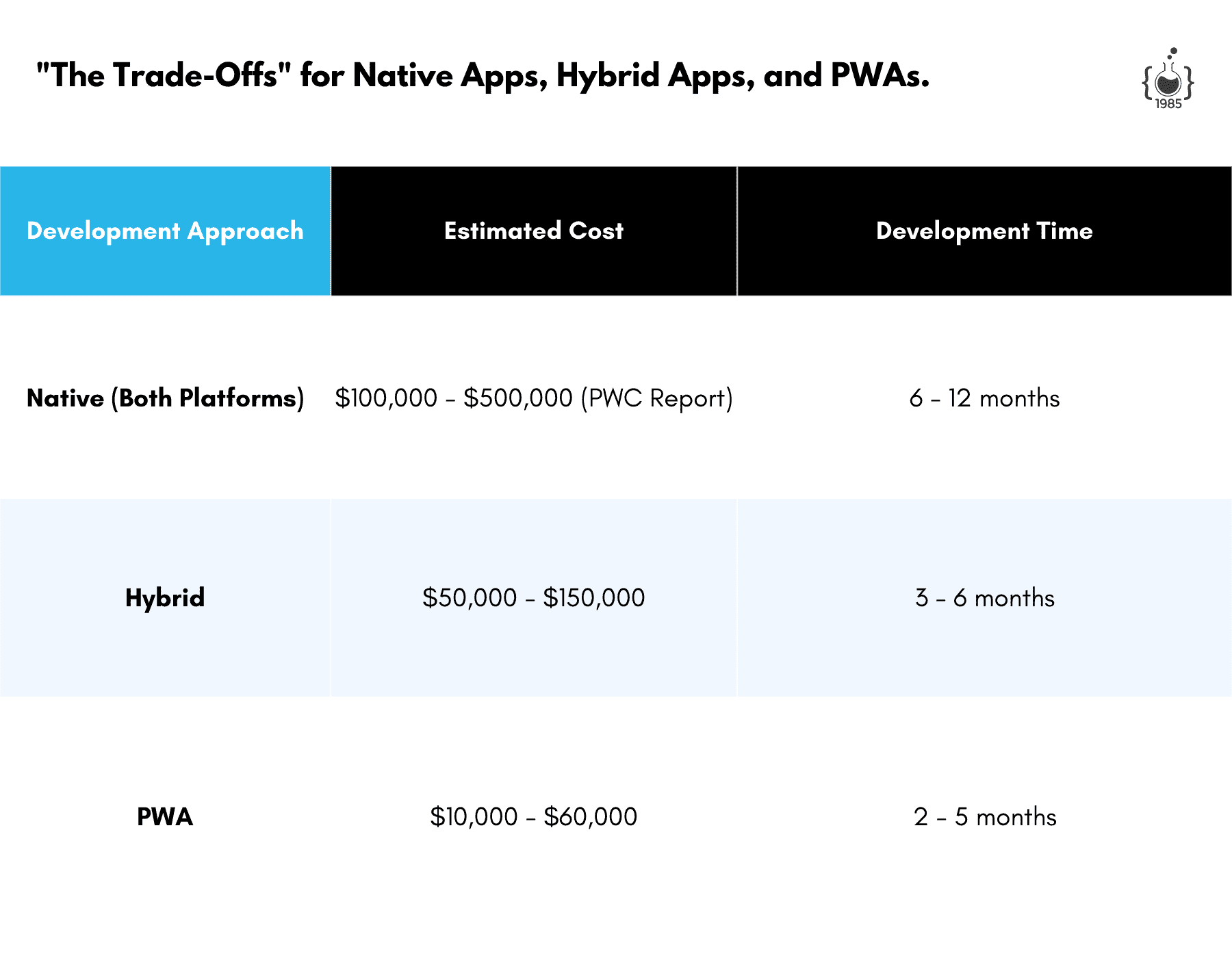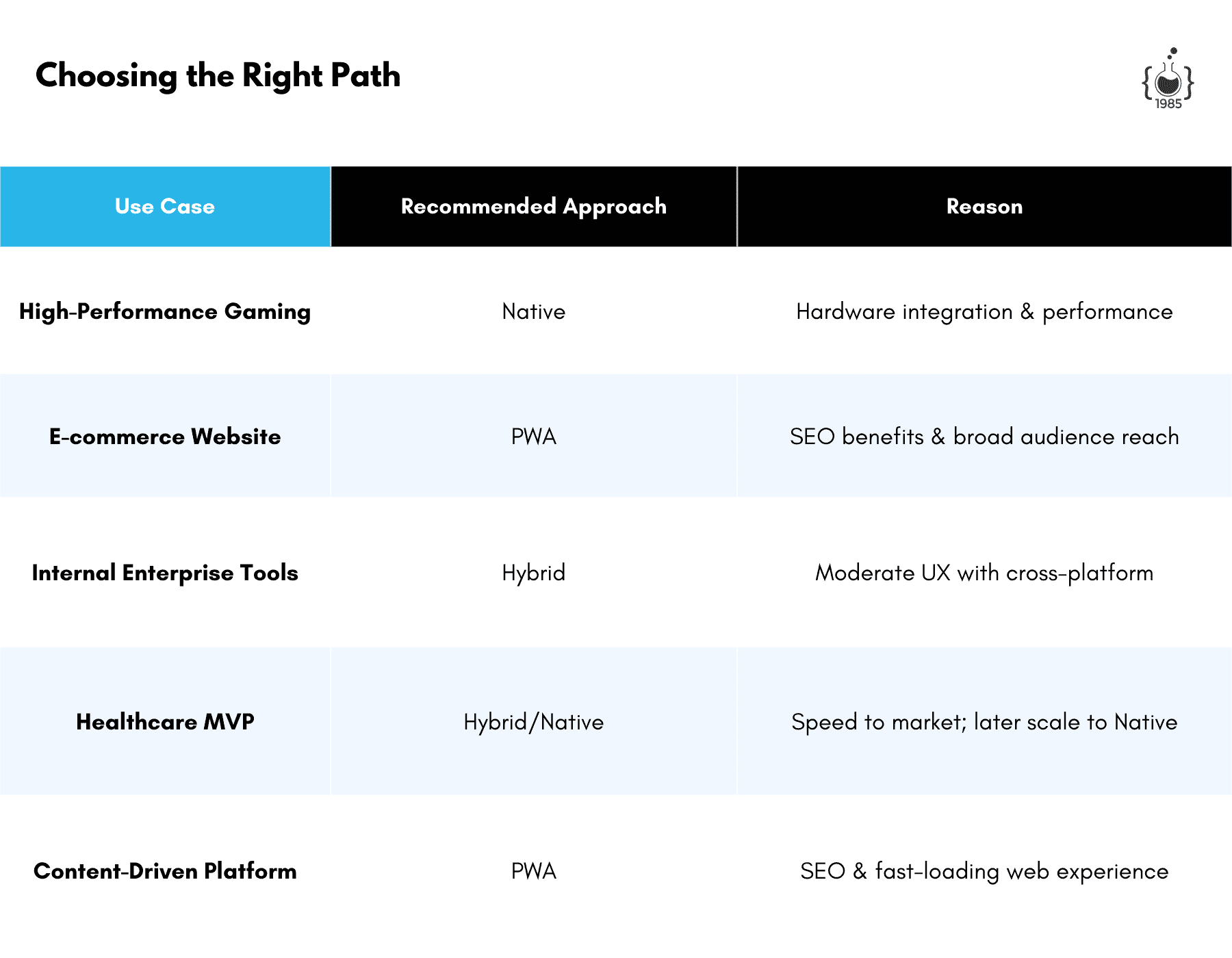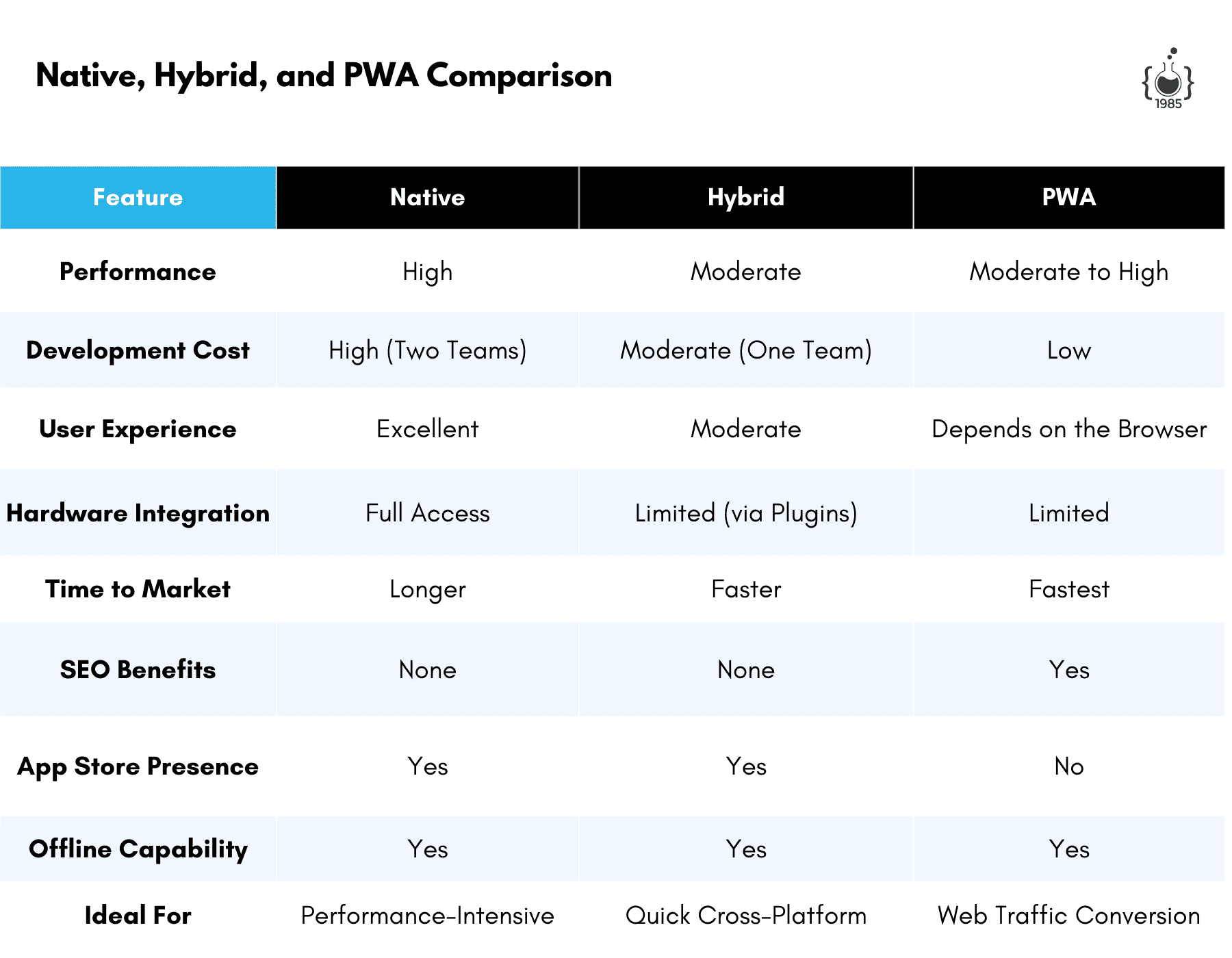Native vs Hybrid vs PWA: Choosing the Right Approach for Your Mobile App
Which mobile app architecture suits your business best—Native, Hybrid, or PWA? Dive deep into their strengths and weaknesses.

If you've ever gone hiking, you know the most critical decision is often made at the very beginning: picking the right trail. Choose the wrong path, and you could end up lost, tired, or worse—wondering why you even bothered. Building a mobile app is kind of like that. You want to choose the right route, the one that’s going to get you to your destination in the best shape possible. Native, Hybrid, or PWA—each approach offers its own pros, cons, and nuances.
My name's Sharath, and at 1985, we help companies, startups, and entrepreneurs navigate these critical decisions. And believe me, it's rarely a straightforward choice. Today, we'll explore what sets Native, Hybrid, and Progressive Web Apps (PWAs) apart—dipping into the technical, the strategic, and the surprising so you can make an informed decision.

Setting the Scene: Why This Choice Matters
Choosing the right kind of mobile app architecture isn’t just about efficiency—it's about survival. Apps are a dime a dozen, and users are fickle. They won’t hesitate to uninstall a laggy, battery-hungry app. Worse, they'll leave a nasty review. So, when it comes to building your app, the stakes are high.

The big choice between Native, Hybrid, and PWA is more than technical. It’s a philosophical one. You’re making a decision that will impact your user experience, your development timelines, and your budget for years to come. And just like hiking, you want to start your journey well-prepared.
Let's go through each path—Native, Hybrid, and PWA—to see what they offer, and more importantly, when each is the best option for your next mobile app.

Native Apps: The Tried-and-True Path
What Is It?
A Native app is like having a tailored suit made just for you. It’s written specifically for a platform—think Swift or Objective-C for iOS, and Java or Kotlin for Android. Each piece is carefully optimized for the environment it’s running in. When you want top-tier performance, native is often your best bet.

The Upsides
- Performance: When you need raw power, native apps win. Apps that demand intensive graphics, like games or real-time analytics dashboards, thrive on native frameworks. Uber redesigned its app to be native after hybrid experiments simply because of performance bottlenecks.
- User Experience: Native apps offer an authentic user experience. The app feels like an organic part of the OS. It uses the latest native APIs, meaning every animation, every swipe gesture—everything—is intuitive for users. Industry studies show that user retention rates for native apps are up to 25% higher compared to their hybrid counterparts.
- Hardware Integration: If your app needs deep integration—think augmented reality (AR), sophisticated camera functions, or seamless communication with external devices—native provides all the hooks into system-level APIs. Consider SnapChat's AR filters—they need to work closely with hardware, and native is the only option for that level of integration.

The Trade-Offs
- Costly and Time-Consuming: Let’s face it—Native development is a resource hog. Writing for both iOS and Android? You’ll need two different teams. Twice the skill set, twice the time, twice the budget. A PWC report found that developing a fully-featured native app could cost between $100,000 and $500,000.
- Fragmentation: Especially with Android, device fragmentation can complicate things. Android apps need to support hundreds of devices, each with a slightly different configuration, leading to increased testing overhead.
- Maintenance Complexity: Every new OS version means updates. Your iOS 15 app might break on iOS 16, necessitating quick updates—with a separate dev pipeline for Android.

Hybrid Apps: A Shortcut With a View
What Is It?
Hybrid apps are essentially web apps bundled into a native wrapper. Technologies like React Native, Flutter, or Apache Cordova have made Hybrid apps quite the tempting option for startups and businesses trying to cut costs or timelines.

The Advantages
- Code Reusability: The holy grail of software development—reuse your code! Hybrid development lets you write code once and deploy it across both iOS and Android. According to a study by Gartner, this often cuts down development time by 30%-50%. At 1985, we've had clients who came to us with deadlines that seemed impossible, but Hybrid saved the day.
- Cost-Effective: With a single team proficient in JavaScript, you can build and deploy to multiple platforms. This significantly lowers the costs of staffing and training.
- Faster Iterations: Hybrid development frameworks come with handy plugins and libraries that make adding features quicker. You can respond to market demands faster. The MVP game becomes a lot more manageable.
The Drawbacks
- Performance Limitations: The performance gap is closing, but it's still there. The hybrid nature can lead to lag, making it less ideal for graphics-heavy applications. For instance, Instagram initially tried hybrid for parts of its app and quickly moved to native as the experience started degrading.
- User Experience: Hybrid apps often miss the nuanced interactions of native. Gesture responsiveness can be laggy, and there’s usually a layer of ‘inconsistency’ in user flow. Users might not be able to articulate it, but they can feel it—a slight, intangible roughness.
- Plugin Dependency: Often, hybrid development relies on third-party plugins to access native device features. While there are plenty available, sometimes a necessary plugin simply doesn’t exist or isn't up-to-date, which could lead to compromised functionality or hacky workarounds.

Progressive Web Apps: The New Trailblazer
What Is It?
Progressive Web Apps (PWAs) are websites built to look and feel like apps. You open them in a browser, but once loaded, they’re cached for offline use. Imagine a fast-loading, installable web app that works offline and can send push notifications—that’s a PWA.

The Good
- Development Simplicity: If you’re already developing a web app, adding PWA capabilities doesn’t require a significant rewrite. You simply enhance what you have. Google reports that Twitter Lite’s PWA uses 70% less data than the native version, leading to a 75% increase in tweets sent.
- Reach: It’s a website, so it’s searchable by search engines. With PWAs, you get some SEO juice alongside the benefits of an app. Pinterest shifted from a native app to a PWA, and saw a 60% increase in core engagements, with user-generated ad revenue up by 44%.
- Cross-Platform: PWAs are true platform agnostics. As long as there's a modern browser, your PWA works. This means incredible reach on mobile, tablet, or even desktops.
The Not-So-Good
- Limited Hardware Access: PWAs can use location, camera, and storage—but not much more. If your app needs advanced hardware integration, PWAs won’t deliver. For instance, integrating AR or sophisticated Bluetooth device communication is off the table.
- App Store Limitations: While some might see this as a feature, the lack of an app store presence can be a negative. People are conditioned to search for apps in stores. If you’re not there, you could miss out on users looking for a ‘trusted’ app experience.
- iOS Barriers: Apple doesn’t exactly roll out the red carpet for PWAs. You can’t send push notifications on iOS devices. They’re not installable in quite the same seamless way as Android. For users heavily immersed in the Apple ecosystem, PWAs may fall short.

Choosing the Right Path: Which Approach for Your Mobile App?
Performance Demands
If your app is computationally heavy—such as for gaming, augmented reality, or video editing—Native is your only option. No matter how far frameworks like Flutter evolve, they simply can’t match the performance Native can achieve at system-level API calls.
Budget Constraints
If you’re on a tight budget but want a presence on both iOS and Android, Hybrid is appealing. However, weigh the trade-offs—would you sacrifice some UX or a bit of speed for cost savings? For many, the answer is yes.

Audience Reach and SEO
Want a seamless way to convert web traffic into mobile users? PWAs shine here. If your goal is to create a shopping experience with broad reach, PWA might be the answer. Think of companies like AliExpress or OLX, which built PWAs and saw massive growth in emerging markets, especially where users prefer lightweight apps.
Speed to Market
Building a Minimum Viable Product (MVP) for rapid market testing? Hybrid lets you push versions fast, reusing code across platforms. In many ways, it’s the golden middle path for projects that require balance.

The Reality of a Nuanced Choice
A lot of articles will try to push you toward a clear winner—Native vs Hybrid vs PWA. The truth is, they’re all evolving, and each can be the right choice depending on the project.
For instance, at 1985, we had a client in the consumer healthcare space who needed to create an MVP to validate their service. We went with Hybrid initially due to budget constraints. But after seeing adoption, they doubled down on Native to improve the patient experience—and it was worth it.
Conversely, another client in e-commerce switched to a PWA to maximize organic search traffic while reaching users beyond app stores. The result? A more cost-effective app development cycle with improved conversion rates.

The Future: Where Are We Heading?
The lines are blurring. Native frameworks like SwiftUI and Jetpack Compose are making it easier to write elegant, less error-prone code. Flutter is improving, offering near-native performance. Browsers are becoming more capable, expanding what PWAs can do.
But what remains the same is user expectation. People want fast, intuitive, and seamless experiences, no matter what tech stack you’re using behind the curtain. User experience isn’t about the choice you make—it's about how well you execute it.
Final Thoughts
There is no “one-size-fits-all” when it comes to app development. Instead, it’s about understanding the trade-offs, weighing the factors that matter most to your project, and executing on your choice effectively. At 1985, we’re always trying to help clients make these decisions with both eyes open—no technical blind spots, no nasty surprises.
Whether you’re a startup building the next great social network or an enterprise needing an internal tool, remember: the journey is as important as the destination. Choose your path wisely—and if you need a guide, we’re here.



